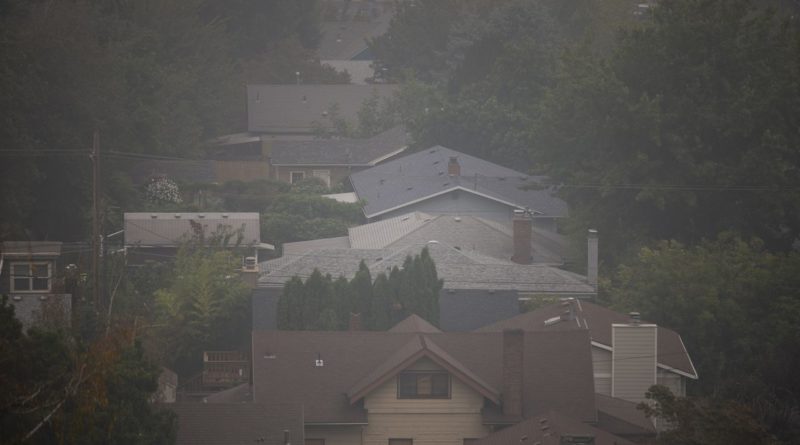Stop wildfire smoke from entering your home: Energy-saving ways to improve indoor air quality – OregonLive
Energy Disrupter
/cloudfront-us-east-1.images.arcpublishing.com/advancelocal/J4YZXFKKBFER3M426WYZX72A7A.JPG)
Prevent harmful wildfire smoke and pollutants from seeping into your home by sealing up air gaps, improving clean air circulation by changing furnace filters, and considering a few other easy-to-do tasks that may also cut down your energy use.
Energy Trust of Oregon experts have low- and no-cost ways to maintain the comfort of your home while cutting energy use and keeping your household healthy during wildfire season.
“With these dry, hot conditions expected to continue through the summer, we want to make sure everyone has information on how to improve their indoor air quality while keeping energy costs low,” said Scott Leonard of Energy Trust.
You can improve one room at a time. If the outdoor air is smoky, plan for you and your pets to stay in a “clean room” with the fewest windows, preferably without a fireplace, vent or other openings to the outside.
If you need one, keep a portable air cleaner or air conditioner running in that room, and dust or mop surfaces with a damp cloth to collect settled particles.
To check the air quality in your area, visit IQair.com. For more information on indoor air quality during wildfires, check out these resources from the U.S. Environmental Protection Agency (EPA).
Or visit the EPA’s air quality website, airnow.gov, and type in your city or ZIP code. View interactive maps at the state’s web page, oregonsmoke.blogspot.com, or the EPA’s web page, fire.airnow.gov.
Here are Energy Trust of Oregon’s top five tips for healthy indoor air:
Typically, you should replace your heating, ventilation and air conditioning (HVAC) filter every three months. During smoke events, your filter may need to be replaced every six weeks to maintain healthy indoor air quality and avoid extra energy use.
Check your filter for dust and debris buildup at least once a month during heavy use and more often in heavy smoke conditions.
Filters with a high minimum efficiency reporting value (MERV) have a much finer weave that catches far more particles compared with standard filters.
High-rated MERV filters can also make some HVAC systems work harder, which can increase energy use. Consult the manufacturer’s manual or website for the best advice on the filters you should be using.
Make sure to switch back to a standard filter after wildfire season. If your HVAC system is designed to work with a high-rated MERV filter, this isn’t an issue, but you should still replace the filter regularly.
Sources for HVAC air and furnace filter replacements:
- The Home Depot has MERV air and furnace filters in various sizes. A basic household, pleated MERV 8 air filter by Rheem is said to capture six times more harmful particles then a fiberglass air filter ($9.98 for a 3-pack of 20 x 20 x 1-inch filters).
- Walmart has Filtrete Smart allergen, bacteria and virus HVAC air and furnace filters (four filters for $15.88 to $78.77 depending on size). Take this quiz to guide you the the filter you need.
Air monitors and air purifiers also need replacement filters to work efficiently.
It is a good idea to use your HVAC system in “fan only” mode during wildfire season. This ensures your system is operating continuously to run your indoor air through the filter.
Remember to go back to “auto” mode before cold weather returns and heating season starts, so that the system kicks on only when needed. That way, you will avoid increasing your energy use and raising your costs.
If pollutants are in the air, turn off anything that draws in outside air, like a fresh air system, dryer or portable air conditioner with a hose vented out a window.
“The biggest question we have been getting is, ‘Should I run my central air conditioner?’” says Rachel Smith of Pyramid Heating + Cooling in Portland. “Yes, you can run your A/C if it is not pulling air from outside. Just make sure to set the fan to ‘on,’ rather than ‘auto,’ to ensure the fan is constantly circulating and filtering air.”
If your doors or windows are drafty, install weather stripping to help prevent smoke from drifting into your house. Check for air leaks around your window air conditioner too.
>The Home Depot has weather stripping foam tape, door bottoms, door seals, thresholds and door sweeps.
If you have a window air conditioner, close the outdoor air damper. If you cannot close the damper, do not use the window air conditioner. Make sure the seal between the air conditioner and the window is as tight as possible.
If you have a portable air conditioner with a single hose, typically vented out of a window, do not use it in smoky conditions. If you have a portable air conditioner with two hoses, make sure that the seal between the window vent kit and the window is as tight as possible.
Do you know the cooling capacity you’ll need based on the room size? Find out with the Home Depot’s air condition calculator.
Avoid activities that create more fine particles indoors: smoking cigarettes; using gas, propane or wood-burning stoves and furnaces; spraying aerosol products; frying or broiling food; burning candles or incense; vacuuming, unless you use a vacuum with a high-efficiency particulate absorbing (HEPA) filter.
When air quality improves, air out your home by opening windows or the fresh air intake on your HVAC system.
Wildfires aren’t the only polluters. Hazardous indoor air quality can be caused by smoke and scents of cigarettes, cooking or household cleaning products that linger without proper ventilation.
High temperature and humidity levels can also increase concentrations of some pollutants, says the EPA.
Outdoor contaminants such as pollen, dander and bacteria can be brought into a home by family members or pets. And everyone’s aware of seasonal allergies.
If you have a portable air cleaner or high-efficiency filter to remove fine particles from the indoor air, run it as often as possible on the highest fan speed.
Sources for a portable air cleaner:
- Allergy Buyers Club has air purifiers on sale and free shipping. Save 42% off the UP3000 UltraPure Air Cleaner (was $1,299, now $749).
- Dyson cooling air purifiers, air purifiers with humidifiers and ones with heaters are certified asthma and allergy friendly by the Asthma and Allergy Foundation of America. See all of Dyson’s air treatment towers that purify, humidify, heat and cool air.
- HoMedics is having a sale on select air purifiers. The TotalClean 5-in-1 UV air purifier with 360-degree True HEPA filtration removes up to 99.97% of airborne allergens as small as 0.3 microns and is on sale for $149.99 (was $199.99). TotalClean Personal UV Air Sanitizer ($49.99) uses UV-C light, not filters, to help kill germs. Save 10% by enrolling in email alerts.
- Walmart has the Coway Airmega AP-1512HH Mighty Air Purifier with True HEPA (high-efficiency particulate absorbing) filters ($163.12, was $249.99). The air purifier covers 361 square feet and captures and reduces up to 99.97% of 0.3 micron particles in the air, including pollen, pollutants and other allergens. It also reduces volatile organic compounds and odors.
- See more Coway air purifiers for the home at Amazon and at CowayMega.com, which has introduced the sleek, advanced Coway Airmega 250 ($399) with a three-stage filtration system for spaces up to 930 square feet.
— Compiled by Janet Eastman | 503-294-4072
jeastman@oregonian.com | @janeteastman
Original Source: https://www.oregonlive.com/wildfires/2021/07/stop-wildfire-smoke-from-entering-your-home-energy-saving-ways-to-improve-indoor-air-quality.html













